The Isaac Newton Telescope Photometric Hα Survey of the Northern Galactic Plane
INT+WFC, WHT+AF2, +ISIS
Hα emission
is ubiquitous in our Galaxy. It traces ionised gas of assorted nebulae
such as H II regions, planetary nebulae, Wolf-Rayet
nebulae, and supernova remnants. It is a strong signature of active stars,
interacting binaries, very massive stars (especially supergiants, Luminous
Blue Variables and Wolf-Rayet stars), Be stars, post-AGB stars, pre-main-sequence
stars and so on. These objects represent important evolutionary phases
which are generally short lived, and are hence few in number and difficult
to find. Their discovery is therefore well worth the effort of a concerted
programme and in August 2003 a major new survey project was started using
the Wide Field Camera (WFC) on the Isaac Newton Telescope (INT) to do just
that. It is called the INT Photometric Hα Survey of the Northern Galactic
Plane, or IPHAS for short.
Its goal
is to conduct an Hα survey of the entire northern Galactic Plane in the
latitude range –5°<b<+5°, a sky area of 1800 deg2,
covering the magnitude range 13<r'<20. When
complete it will represent an enormous improvement over previous work. The final catalogue of IPHAS point sources will contain photometry on about 80 million objects. Used on its own, or in combination with near-infrared photometric catalogues, IPHAS will be a major resource for the study of stellar populations making up the disc of the Milky Way. The eventual yield of new northern emission-line objects from IPHAS is likely to be an order of magnitude increase on the number already known.
Below there are some images based on data obtained as part of IPHAS, and they were prepared by Nick Wright, University College London.
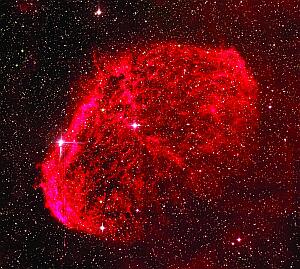
|
Figure 1. The crescent nebula, NGC6888, which surrounds the Wolf-Rayet star PPM 84423, seen in Hα emission by IPHAS
[ JPEG | TIFF].
|
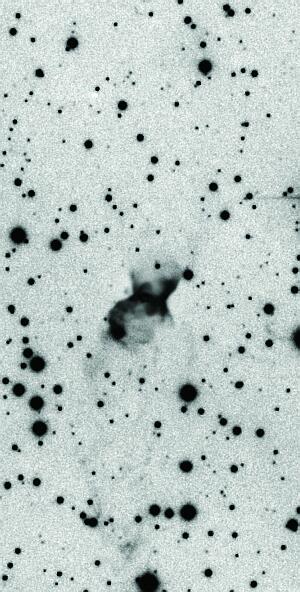
|
Figure 2.
The newly discovered Planetary Nebula PN 126.62+1.32, the "Prince of Asturias" (named after the wedding of the Spanish Prince), is a rare quadrupolar nebula (central region), with extended fainter lobes extending over 16 arcminutes from the central star [ JPEG | TIFF].
|
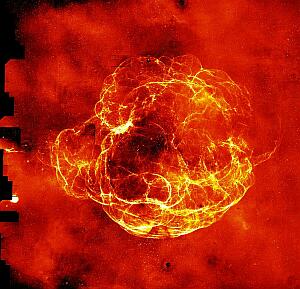
|
Figure 3. A 5°×3.5°
mosaic of the supernova remnant S147 in Hα. North is to the top and East
to the left [ JPEG | TIFF].
|
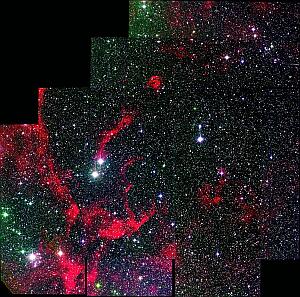
|
Figure 4.
Filamentary Hα emission in Cygnus, observed as
part of IPHAS. The colour scheme is red for Hα, blue for the Sloan r' band, and green for
Sloan i' band. As this is a significantly reddened region, as well as nebulous,
there are many stars coming through strongly in the i' band, appearing here
as a background of green stars [ JPEG | TIFF].
|
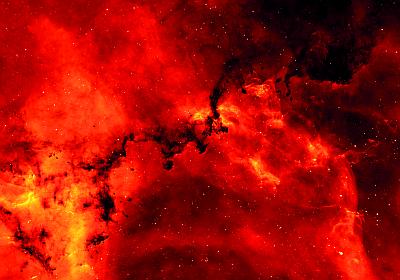
|
Figure 5.
Dust lanes in the centre of the Rosette Nebula. Image produced by
Nick Wright (UCL) on behalf of the IPHAS collaboration. Size is 30×20
arcmin, north to the left, east is down. This image was taken as part
of the IPHAS survey and are primarily Hα images taken with the WFC
on the INT [ JPEG | TIFF].
|
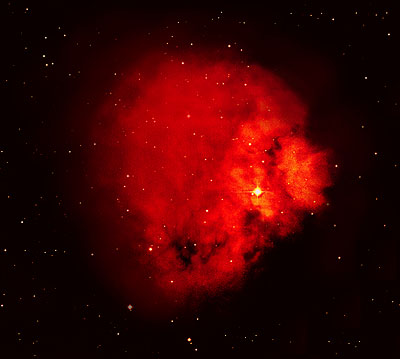
|
Figure 6.
Sh2-242 is a small HII Region on the edge of a molecular cloud that lies just southeast of the supernova remnant Simeis 147 in the constellation of Taurus. There is evidence that this molecular cloud may contain a young stellar cluster of newly-born stars. Scale is approximately 10×10 arcmin. North is down and East to the right [ JPEG | TIFF].
|
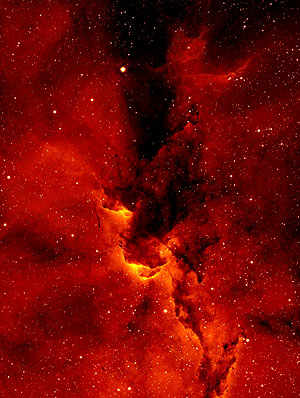
|
Figure 7.
IC1396, The Elephant Trunk Nebula, is one of the youngest and most active nebulae in our galaxy, lying at a distance of approximately 2000 light years from us. This giant cloud of gas and dust is illuminated by a massive central star whose radiation is triggering star formation throughout the region. This image, approximately 15 light years across, shows a prominent edge-brightened limb, embedded deep within which, new stars are forming all the time. Scale is approximately 15 × 20 arcmin, North to the left, East is down [ JPEG | TIFF].
|

|
Figure 8.
The Pelican Nebula is a massive nebula in the constellation of Cygnus. It lies close to the North American Nebula, the two being separated by a giant dust cloud. This image shows the main ionization front of the Pelican Nebula which makes up the head and neck of the Pelican. Recent observations have identified many new Herbig-Haro objects in this area, including two that can be seen in this image, the first on the far right hand side and the second at the end of the dust column in the second. Scale is approximately 25×15 arcmin, North is to the left, East is down [ JPEG | TIFF].
|
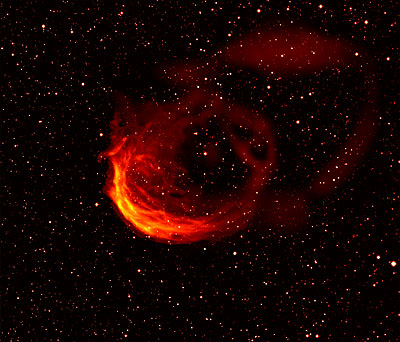
|
Figure 9.
Sh 2-188 is a wind blown Planetary Nebula in Cassiopeia. It is a perfect example of a strong interaction between a planetary nebula and the interstellar medium. It shows a single arc-like structure with a faint, thin arc behind it. Also visible is a longer, wide arc extending away from the nebula itself. Recent studies have shown this shape to be due to the motion of the PN through the interstellar medium at a velocity of 125 km s -1. Field of view is 22 × 22 arcmin, North is up, East to the left [ JPEG | TIFF].
|
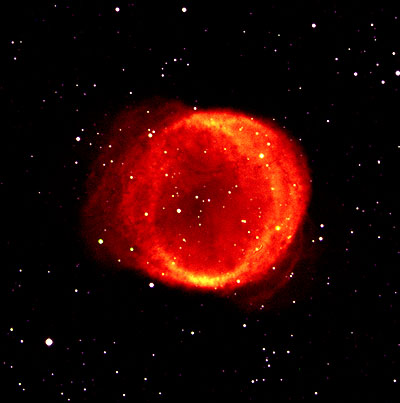
|
Figure 10.
NGC 6781 is a small bubble-shaped planetary nebula. It is approximately 2 light years across and shows some structure in the centre similar to that seen in the Helix Nebula. Field of view is 6×6 arcmin [ JPEG | TIFF].
|
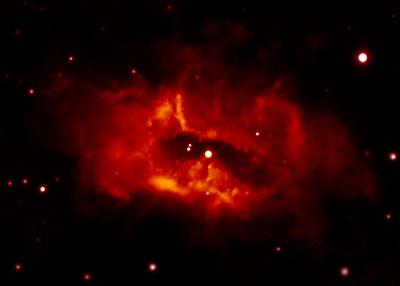
|
Figure 11.
Sh 2-71 is quite an irregular planetary nebula. The central star is a variable star, and this may explain the strange shape of the nebula itself. Field of view is 4×3 arcmin [ JPEG | TIFF].
|
References:
- J. E. Drew et al., 2005, MNRAS, 362, 753.
- J. E. Drew et al., 2005, ING Newsl., 9, 3.
- "New Star Survey Sheds Light on the Evolution of Galaxies", Imperial College Press Release, 20th September 2005.
- IPHAS: The INT/WFC Photometric H-alpha Survey of the Northern Galactic Plane.
|













